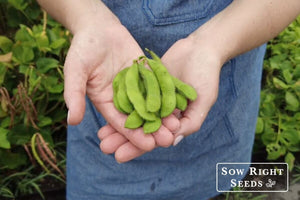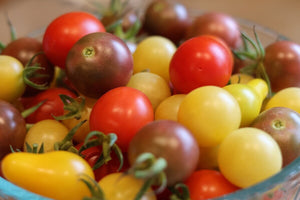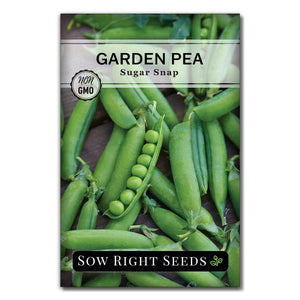Why You Should Be Growing Fresh Garden Peas and How to Get Started
PeasPeas are the first thing to come to mind when I think of spring gardening. As soon as the soil is warm enough to work, they’re the first seeds you can sow outside. And, of course, there’s no substitute for their garden fresh flavor! You’ll never eat a pea that tastes as good as one you just picked from your garden. Follow these simple steps to get peas growing in your garden.

How to Grow Peas
Peas are a cool season crop that grows fast, produces for 2 to 3 weeks, and then they’re done. This makes them a great choice for spring gardening. Peas don’t transplant well and are usually planted directly into the garden with these easy tips.
Prepare the Soil:
Peas can be planted in early spring as soon as the ground can be worked. What this means is the soil is no longer frozen and about 50º. Since peas need to be directly sown, you will want a well-prepared space for them.
Choose a location that gets 3 to 4 hours of sunlight per day and has a trellis, fence, or another type of support for the peas to climb. Peas can grow around 5 feet high. So whatever type of supports you use, make sure they can handle the height and weight and not fall over on a windy day. Read more about plant supports here.
Prepare the soil to a depth of 1 foot. Peas thrive in rich, fertile soil that is moist but well-draining. A pH of 5.8 to 7 is recommended.

Sow the seeds:
You can soak peas for 8 to 12 hours before planting. This allows them to absorb water quicker than sitting in moist soil. But peas will also sprout without presoaking.
Plant peas at a depth of 1 inch and space 2 inches apart.
Press the soil firmly around the seeds and water thoroughly. You shouldn’t have to water again until they start to sprout in 6 to 10 days.
Have your supports ready, as the plants will grow quickly, sending out tendrils to help them climb.
To extend your harvest, do succession planting. Every 2 weeks, plant some more peas. That way, you will have a longer harvest. Read here for more specifics on succession planting.
Once your peas are planted, you can sow radishes and carrots next to them. And when the peas start flowering, you can plant cucumbers. By the time the peas are finished, the cucumbers can grow up the same supports.

When to Plant Peas:
Plant peas in early spring as soon as the ground has warmed up to 45ºF.
Sow peas directly into the garden 4 to 6 weeks before the last spring frost. (For a fall harvest, sow peas outdoors in late summer.)
Peas will grow best in cool weather. So, the best time to plant peas will be determined by your local weather.
Growing Peas:
Peas have moderate watering needs. An inch of water a week is usually sufficient. Once they start flowering, make sure the plants are getting enough water, as this is a critical growing time.
The ideal temperature for growing peas is 68º to 77º. This temperature will give the best yields. However, when temperatures rise over 86º, peas will have poor pollination and rapidly over-mature.
Peas only produce for 2 to 3 weeks. So consider succession planting for a more extended harvest season.

Harvesting Peas:
Pick peas every day or every other day to keep them producing. You will also want to check frequently because they grow fast. Peas ripen on the bottom of the plant first, so check your plants from the bottom to the top.
As soon as peas are picked, they start converting the plant sugars into starch. That’s why you’ll never eat a pea that tastes as good as the one you just picked.
Once picked, you can store peas in the fridge (I prefer a zip-top bag) to keep them fresh. But again, they are best eaten the same day since they immediately start losing their sugar content.
You can also eat raw pea tendrils and shoots. Just leave enough tendrils for the peas to stay connected to the supports as they climb. If you like pea tendrils, try growing our pea microgreens.
Types of Garden Peas
There are 3 kinds of peas to sow in your garden.
While they can all be planted the same way, knowing which kind of pea you are growing will help you harvest at the right time.
English peas are also called garden peas. These are the ones where the pods are discarded, and you eat the peas inside. Garden peas are harvested when the peas have grown to full size, and the pods are still bright green. Once the pods look dull and dry or start turning brown, they are past their prime for eating.
Sugar snap peas have crisp edible pods with full-size peas inside. These are delicious to eat while you wander through the garden on a cool spring morning. Sugar snap peas can be harvested at any time before the peas are fully mature. Some gardeners like to have bigger peas inside, and others prefer the peas to be less developed.
Snow peas also have edible pods, but the peas are still young and flat. They are often added to salads and stir-fries.
When your peas have finished growing, cut the plants off at the ground level and leave the roots in the ground to increase nitrogen levels in the soil for your next crop.
2 Reasons You Should Plant Peas
Besides being incredibly fresh tasting, there are 2 important benefits of growing peas.
1 - For your health.
Peas are a high-fiber food that helps keep blood glucose low after meals and contributes to lowering cholesterol and blood pressure. Peas are also high in protein, vitamin C, vitamin K, and several phytonutrients.
2 - For soil health.
Peas are also beneficial for soil health. They fix nitrogen from the air, returning it to the soil to benefit other plants. Tomatoes, peppers, corn, cucumbers, squash, and okra, are just some of the plants that need nitrogen in the soil. Planting peas as part of your garden rotation will resupply the nitrogen needs for other vegetables.

Peas are such a healthy vegetable to grow for both your body and your garden soil. So plant some peas in your garden to enjoy an easy harvest of the freshest flavor you can’t get anywhere else.








Leave a comment